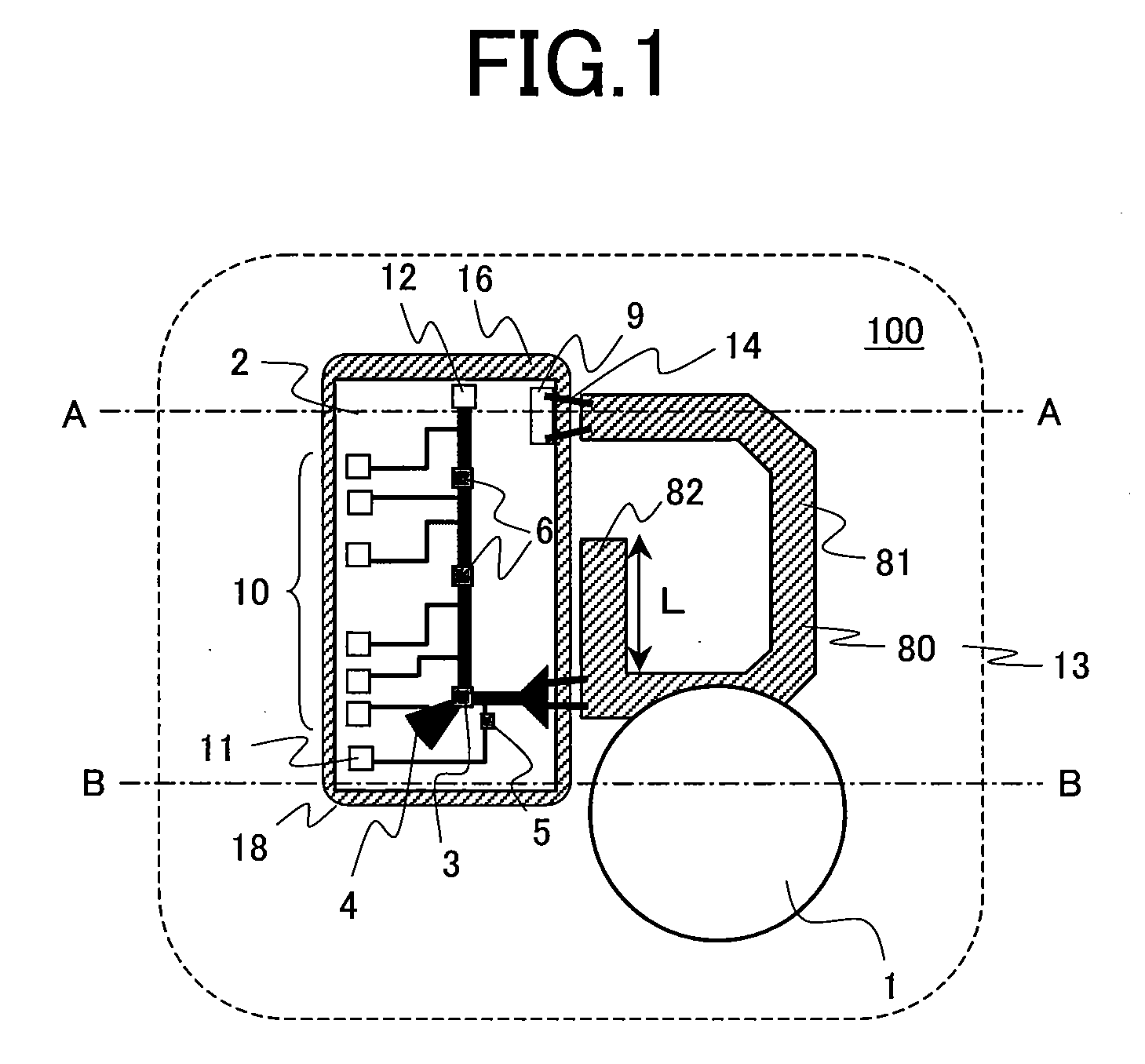Dielectric resonator oscillator and radar system using the same
- Summary
- Abstract
- Description
- Claims
- Application Information
AI Technical Summary
Benefits of technology
Problems solved by technology
Method used
Image
Examples
first embodiment
[0037]The first embodiment according to the present invention is explained in reference to FIGS. 1, 2A to 2D, and FIGS. 3A and 3B. FIG. 1 is a top view showing a dielectric resonator oscillator according to the first embodiment of the present invention. FIG. 2A is a sectional view taken on line A-A in FIG. 1. FIG. 2B is a sectional view taken on line B-B in FIG. 1. FIG. 2C is a view explaining the configuration of the first embodiment. FIG. 2D is a view explaining a modified example of the first embodiment.
[0038]In a dielectric resonator oscillator 100 according to the present embodiment, a dielectric resonator 1, an MMIC 2, and a transmission line 81 are formed on a common dielectric substrate 13. That is, on a multilayered dielectric substrate 13, a layered structure comprising a bottom conductive layer 16a, inner conductive layers 16, inner dielectric layers 17, and a top dielectric layer 17a, a columnar dielectric resonator 1, and an MMIC chip 2 are disposed. The multilayered di...
second embodiment
[0053]A dielectric resonator oscillator (DRO) 100 according to the first embodiment is used as a signal source of a radar module, a radar system, or a communication system using a microwave or a millimeter wave.
[0054]As the second embodiment according to the present invention, an example of a configuration of the case where the DRO 100 according to the first embodiment is applied to a radar system using a microwave or a millimeter wave is shown. FIG. 4 is a top view showing a transmitting and receiving module substrate comprising a transmitting and receiving module and a transmitting and receiving antenna and FIG. 5 is a circuit block diagram thereof.
[0055]As a transmitting and receiving module 200 for a radar system, a power amplifier MMIC 2a to amplify transmitting signals and two units of receivers MMICs 2b to mix receiving signals with local signals and generate IF signals are mounted on the multilayered dielectric substrate 13 as a shared ceramic substrate in addition to the DR...
third embodiment
[0060]Successively, as the third embodiment of the present invention, an example of concrete procedure in the case where the DROs 100 according to the first embodiment are produced in quantities is explained in reference to FIGS. 6 to 8. FIG. 6 is a graph showing the correlation between an open stub length L and an oscillating output power Pout in consideration of the difference between individual DROs and FIG. 7 is a graph similarly showing the correlation between an open stub length L and an oscillating frequency fosc . Further, FIG. 8 shows an assembly flow at the mass production of DROs.
[0061]The correlations of the oscillating output power Pout and the oscillating frequency fosc with the open stub length L vary in ranges in accordance with individual DROs as shown in FIGS. 6 and 7, reflecting the difference in the positions of dielectric resonators, the difference in the characteristics of MMICs, the difference in the length of wires, and others among the components of the DROs...
PUM
 Login to View More
Login to View More Abstract
Description
Claims
Application Information
 Login to View More
Login to View More - R&D
- Intellectual Property
- Life Sciences
- Materials
- Tech Scout
- Unparalleled Data Quality
- Higher Quality Content
- 60% Fewer Hallucinations
Browse by: Latest US Patents, China's latest patents, Technical Efficacy Thesaurus, Application Domain, Technology Topic, Popular Technical Reports.
© 2025 PatSnap. All rights reserved.Legal|Privacy policy|Modern Slavery Act Transparency Statement|Sitemap|About US| Contact US: help@patsnap.com



